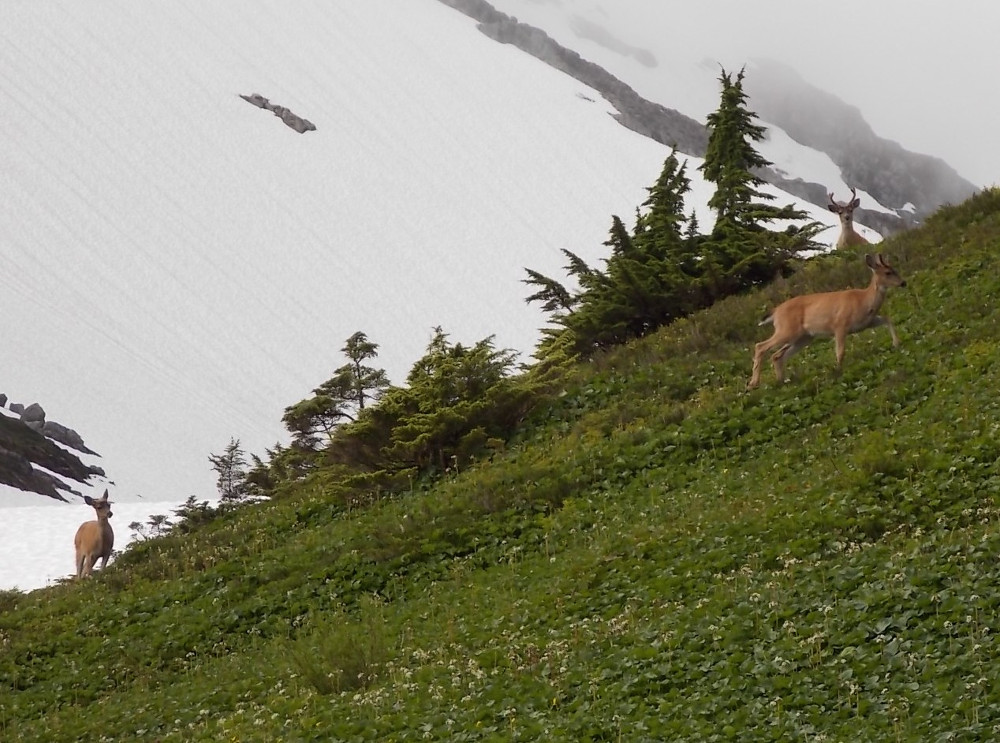
Three deer make their way through an alpine meadow south of Scott Peak on northeast Kupreanof Island near Petersburg. (Joe Viechnicki/KFSK)
The U.S. Ninth Circuit Court of Appeals has ruled in a decade-old lawsuit against four timber sales planned on the Tongass National Forest. The federal appeals court sided with environmentalists who claimed the logging plans underestimated impacts on deer habitat.
The sales were approved by the Forest Service back in 2006 and 2007. Greenpeace and Cascadia Wildlands filed suit in 2008 alleging the Forest Service’s methods for calculating deer habitat was flawed.
“We’re thrilled by the ruling,” said Larry Edwards, a Greenpeace representative in Sitka. “We were very confident in this case all along.”
The lawsuit challenged how the Forest Service projects logging’s impact on deer habitat. The animals are the primary prey of wolves and important for hunters in the region.
“There’s a standard and guideline in the forest plan that sets a minimum threshold as a guideline for how much habitat should be provided and in all these projects, there was already insufficient deer carrying capacity if the modeling were done correctly even before any logging is done on these projects, just due to past logging,” Edwards explained.
Two of the proposed sales are near Petersburg. The Overlook sale was planned on central Mitkof Island and logging was also planned near Scott Peak on northeast Kupreanof Island. The other sales are Soda Nick, near Hydaburg on Prince of Wales Island, and Traitor’s Cove north of Ketchikan.
The Forest Service subsequently changed the way it models deer habitat impacts in 2008. A judge sided with the government in 2010. But environmentalists appealed and won. The court kicked the timber sales back to the Forest Service for revision. The case was dismissed last year. Once again the groups appealed.
Attorney Oliver Stiefel made the group’s case before the appeals court in August. “This case has been ongoing for the past 12 years,” he said. “The Forest Service has now had three opportunities to explain its use of the deer model and consistency with the governing forest plan. It has failed each time and we think it’s time for the agency to go back to the drawing board.”
Government attorney Michael Gray made the Forest Service’s case on appeal. “The Forest Service has now adequately explained exactly how this works, why its decision at the time was correct and has now done the model that the plaintiffs say is fine and said our decision wouldn’t change because the impacts wouldn’t change,” Gray argued.
A three-judge panel of the 9th Circuit Court of Appeals disagreed with the government. And in a ruling issued November 28th it found the Forest Service had used a flawed model to classify deer habitat and failed to explain how its habitat estimate complied with the forest plan. The judges also questioned “why it was authorizing the projects despite lower-than-recommended deer habitat capabilities.”
The ruling is effectively reverses the approval of the four projects that would have offered 33 million board feet of timber from 1,700 acres. The Forest Service can now either appeal this decision or restart its environmental review. The agency referred request for comment on the decision to the Department of Justice.









